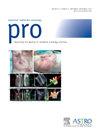RAdiotherapy Dose Accumulation Routine (RADAR)-A Novel Dose Accumulation Script With Built-In Uncertainty
IF 3.5
3区 医学
Q2 ONCOLOGY
引用次数: 0
Abstract
Purpose
To incorporate uncertainty into dose accumulation for reirradiation.
Methods and Materials
The RAdiotherapy Dose Accumulation Routine (RADAR) script for the Eclipse treatment planning system (Varian Medical Systems) is described, and the voxel-wise ellipsoid search algorithm is introduced as a means of incorporating uncertainty. RADAR is first demonstrated on a test patient reirradiated to the spine, illustrating the effect of the uncertainty algorithm. A summary of initial evaluation testing conducted by 11 users, each of whom ran a separate spine reirradiation case, follows. Finally, RADAR run times are reported for various conditions.
Results
In the demonstration case in which a 3-mm ellipsoid search was used, the maximum RADAR 2-Gy equivalent (EQD2) accumulated spinal cord dose increased from 7244 to 12,689 cGy because the ellipsoid search pulled dose from closer to the adjacent target structure. When the ellipsoid search was restricted to voxels within the spinal cord, the maximum accumulated cord dose was reduced to 6523 cGy and did not exceed the sum of the maximum EQD2 spinal cord doses of the individual plans (6730 cGy). In the evaluation cases, the RADAR EQD2 maximum dose for the spinal cord increased by an average of 31.6% with uncertainty applied compared to a conventional dose accumulation and decreased by an average of 16.7% compared to a conventional dose accumulation when the uncertainty calculation was restricted to voxels within the spinal cord. RADAR run times vary depending on the number of plans added and the type of uncertainty used.
Conclusions
RADAR offers a novel way to directly account for uncertainty in dose accumulation through a voxel-wise ellipsoid search algorithm. EQD2 dose accumulation with and without dose discounts is also available.
放射治疗剂量累积程序 (RADAR) - 一种新颖的剂量累积脚本,具有内置的不确定性。
目的:将不确定性纳入再照射的剂量累积:方法:介绍 Eclipse 治疗计划系统(瓦里安医疗系统公司,加利福尼亚州帕洛阿尔托)的 RADAR 脚本,并引入体素椭圆搜索算法作为纳入不确定性的一种手段。RADAR 首先在脊柱再照射的测试病人身上进行了演示,说明了不确定性算法的效果。随后对 11 位用户的初步评估测试进行了总结,每位用户都运行了一个单独的脊柱再照射案例。最后,报告了不同条件下雷达的运行时间:在使用 3 毫米椭圆搜索的演示案例中,雷达 2 Gy 当量(EQD2)累积脊髓剂量最大值从 7244 cGy 增加到 12689 cGy,这是因为椭圆搜索将剂量从邻近目标结构拉近。当椭圆体搜索仅限于脊髓内的体素时,最大累积脊髓剂量降至 6523 cGy,且未超过单个计划的最大 EQD2 脊髓剂量之和(6730 cGy)。在评估案例中,与常规剂量累积相比,雷达 EQD2 脊髓最大剂量在应用了不确定性后平均增加了 31.6%,而当不确定性计算仅限于脊髓内的体素时,与常规剂量累积相比平均减少了 16.7%。RADAR的运行时间取决于添加的计划数量和使用的不确定性类型:RADAR提供了一种新方法,通过体素椭圆搜索算法直接计算剂量累积的不确定性。此外,还提供了有剂量折扣和无剂量折扣的 EQD2 剂量累积。
本文章由计算机程序翻译,如有差异,请以英文原文为准。
求助全文
约1分钟内获得全文
求助全文
来源期刊

Practical Radiation Oncology
Medicine-Radiology, Nuclear Medicine and Imaging
CiteScore
5.20
自引率
6.10%
发文量
177
审稿时长
34 days
期刊介绍:
The overarching mission of Practical Radiation Oncology is to improve the quality of radiation oncology practice. PRO''s purpose is to document the state of current practice, providing background for those in training and continuing education for practitioners, through discussion and illustration of new techniques, evaluation of current practices, and publication of case reports. PRO strives to provide its readers content that emphasizes knowledge "with a purpose." The content of PRO includes:
Original articles focusing on patient safety, quality measurement, or quality improvement initiatives
Original articles focusing on imaging, contouring, target delineation, simulation, treatment planning, immobilization, organ motion, and other practical issues
ASTRO guidelines, position papers, and consensus statements
Essays that highlight enriching personal experiences in caring for cancer patients and their families.
 求助内容:
求助内容: 应助结果提醒方式:
应助结果提醒方式:


